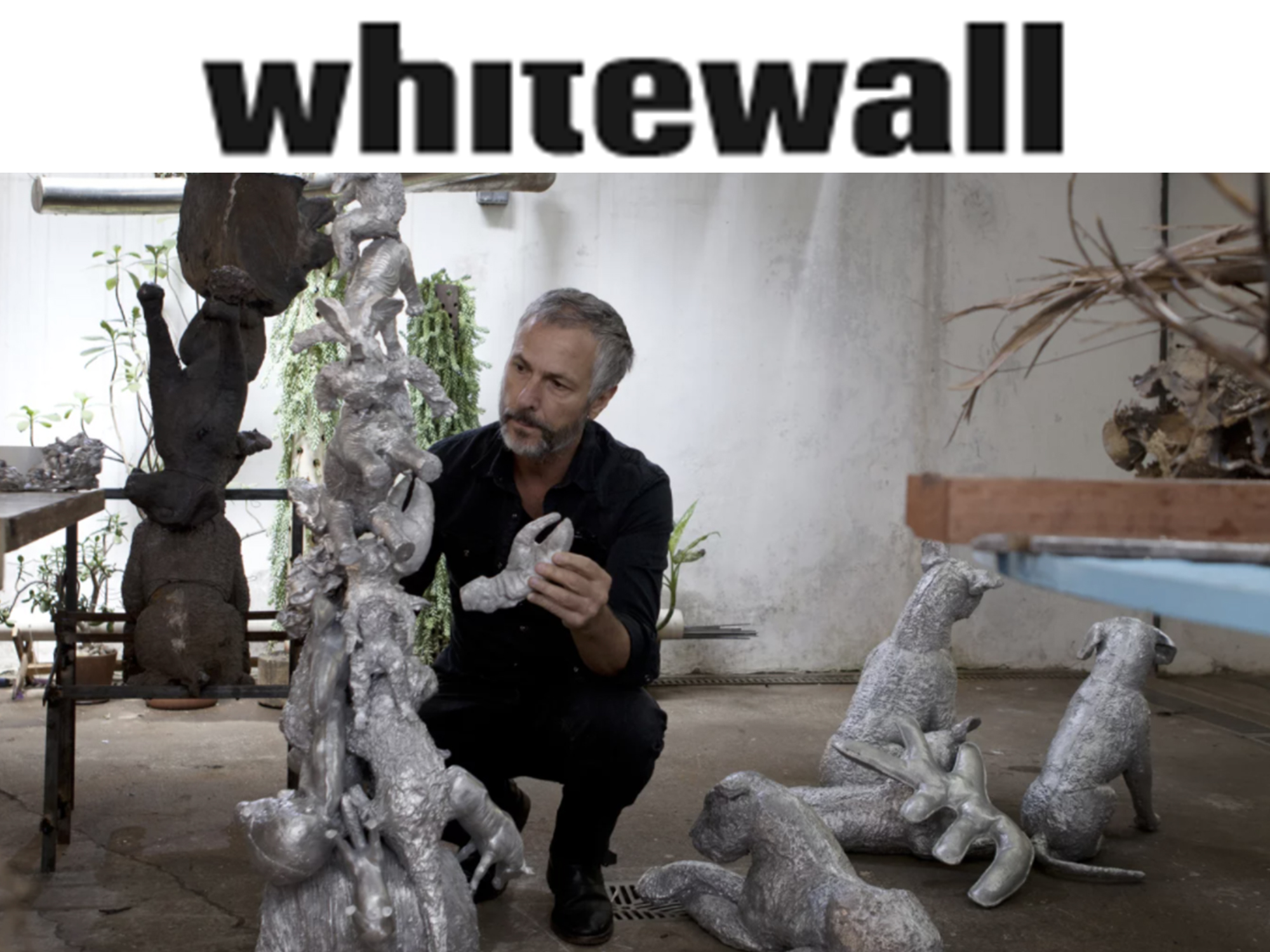By Katy Donoghue
Humberto and Fernando Campana have always made furniture that, while functional, dances with ideas of surrealism and sculpture. They have made chairs out of stuffed animals, credenzas out of colorful foam rolled to look like sushi, a couch from a collage of bronze figures referencing the Baroque period.
For “Hybridism,” their recent exhibition at Friedman Benda in New York (September 7—October 14), the Campana brothers freed themselves of all practicality and created objects that can comfortably be called art. A few, yes, you could sit on, but their purpose is really to dazzle the eye, stimulate the imagination, and capture the current mindset of the designers behind them. There’s what looks like a fallen log cast in bronze, with a seat carved out and filled by a woven web of fabric that calls to mind a bed of insects. There’s a mantel held up by a tangle of alligators and birds. There are totems to Noah and his ark, with a monkey head as the base and an elephant up top. And a webbed green velvet oblong form is being pulled apart by goats and dogs from within.
“Hybridism” feels like a dream, at times chaotic and frenzied, and in other moments magical and beautifully bizarre. Whitewall spoke with Humberto Campana over the summer about how he and his brother give form to the upside-down feeling of life in São Paulo and elsewhere in the world today.
WHITEWALL: How did you find yourselves going in this a new direction, moving overtly toward sculpture?
HUMBERTO CAMPANA: It’s much more in the direction of art than design. Our work sometimes flirts with surrealism, and we wanted to bring all these elements of surrealism and dreams into this exhibition. The idea of this exhibition is about the present time the planet is living in politically. The world is upside down and feels completely crazy. So we tried to bring this experience and feeling of living in this situation and present in the exhibition.
WW: Was it a subconscious reaction, or was there a choice to address this moment?
HC: I jog every day in a park in São Paulo and along the way noticed there was a lot of tree bark on the ground. So I cast that bark and created an object. But everything starts unconsciously. I started casting objects that could be transformed into another object. Now with the exhibition almost finished, I see there is a connection with this moment.
Brazil today is completely upside down. It feels like there is no hope. It’s very difficult, as it is in the whole world. So all these things have the connection with things my brother and I experience.
WW: Does the title of the show, “Hybridism,” reference the materials as well?
HC: Yes. The metal of bronze and aluminum is present in the whole exhibition but mixed with woven fabrics, woven velvet, or wicker. The exhibition is all handmade. There are people that cast the objects in a foundry. Then I bring them to my studio and with the help of an artisan, we weld all the bronze and aluminum pieces together to create a sculpture.
There was an idea to be much more personal about what affects my brother and me. In the past, I didn’t want to. But now, this is totally a dream, to be free—to be free in terms of no attachment with design or functionality or practicality. We gave that freedom to ourselves.
WW: What did it feel like to experience that freedom?
HC: It was a good experience because it was a new direction. I like seeing people’s reaction, to observe people looking at those objects. After 34 years of creating objects, I need to move, I need to breathe another experience.
I like to visit certain experiences. Our design is not dry. Sometimes we create scenography or landscaping or fashion, design furniture—everything that connects to creativity. This, I guess, is the main character of our work. It’s fluid. It’s liquid.
WW: You are no stranger to moving between fields of creativity.
HC: We are hybridists. All the objects we create are a shock between materials. Most of the pieces are very big and very heavy. But I like this. The aspect of heaviness is about my maturity, how I’m grounded.
WW: Can you tell me about the Campana Institute, the nonprofit you and your brother founded to promote and preserve Brazilian art and culture?
HC: The first idea was to preserve our memory and create a small museum of our work. And then we started to move into social aspects, collaborating in a favela in São Paulo where we teach children to not get involved with crime. We teach them to work with materials that they find in the street, and we create toys. Or we are teaching women to create objects in order to sell what they create to companies I get in contact with.
When I first encountered the kids, it was tough. The first objects they created were toy guns and things to connect to criminality. The idea is to give them self-esteem to go in another direction or to have another view of our society. Sometimes we bring them to museums or movies, to enlarge their universe.
We created a chair named Favela, I guess 15 years ago now. And we had no real idea about what the favela really was. I just tried to make a portrait of a favela into an object. But I never experienced the lives there. And there was always a noise in my mind, “You should do something for them. You gave a name for a chair—you need to be responsible with this attitude.” So now we are revisiting this in order to make a balance, and not to have noise. I try not to have noise in my head.










